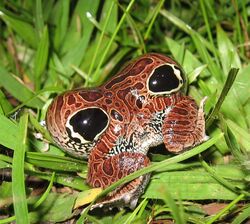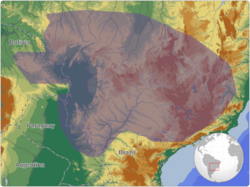Biology:Physalaemus nattereri
| Physalaemus nattereri | |
|---|---|

| |
| Scientific classification | |
| Domain: | Eukaryota |
| Kingdom: | Animalia |
| Phylum: | Chordata |
| Class: | Amphibia |
| Order: | Anura |
| Family: | Leptodactylidae |
| Genus: | Physalaemus |
| Species: | P. nattereri
|
| Binomial name | |
| Physalaemus nattereri (Steindachner, 1863)
| |

| |
| Synonyms[2] | |
| |
Physalaemus nattereri (common name: Cuyaba dwarf frog) is a frog native to central and southeastern Brazil and eastern Bolivia and Paraguay.[2]
Description
It has two "false eyes" on its rear. The 3–4 cm frog lifts its rear end when threatened, startling predators. If a predator does not get fooled by the eyespots, and decides to move closer, the frog can produce an unpleasant secretion that comes from glands located in the eyespots.[3] Similar display is known from Physalaemus deimaticus.[4]
Reproduction
A study in Bodoquena (in the Mato Grosso do Sul state of Brazil) found Physalaemus nattereri to be an explosive breeder, with most of the reproductive activity occurring within a few days after heavy rainfall. Males formed choruses to attract females but they could also actively search for females. Egg clutches were deposited in the margins of temporary ponds. Several pairs may use the same foam nest. Mean clutch size was about 3800 eggs. Females were larger (mean snout–vent length 51 mm (2.0 in), range 43–56 mm; mean body mass 19.3 g) than males (47 mm (1.9 in), range 43–55 mm; 11.4 g). Ovaries made about 22% of female body mass; fecundity increased with the female body size.[5]
Habitat and conservation
Physalaemus nattereri is a fossorial and seasonal frog. It inhabits savannas and grasslands in the Cerrado biome and is found on the ground near standing and temporary waterbodies, such as ponds and swamps. It could be locally threatened by spread of intensive agriculture. It is present in several protected areas.[1]
References
- ↑ 1.0 1.1 Lucy Aquino, Steffen Reichle, Débora Silvano, Norman Scott (2004). "Physalaemus nattereri". IUCN Red List of Threatened Species 2004: e.T57267A11597340. doi:10.2305/IUCN.UK.2004.RLTS.T57267A11597340.en. https://www.iucnredlist.org/species/57267/11597340. Retrieved 19 November 2021.
- ↑ 2.0 2.1 Frost, Darrel R. (2018). "Physalaemus nattereri (Steindachner, 1863)". Amphibian Species of the World: an Online Reference. Version 6.0. American Museum of Natural History. http://research.amnh.org/vz/herpetology/amphibia/Amphibia/Anura/Leptodactylidae/Leiuperinae/Physalaemus/Physalaemus-nattereri.
- ↑ Camouflage and Mimicry - Owen, Dennis Frank, 1980
- ↑ Sazima, I.; Caramaschi, U. (1986). "Descricao de Physalaemus deimaticus, sp. n., e observacoaes sobre comportamento deimatico em P. nattereri (Steindn.) — Anura, Leptodactylidae". Revista de Biologia 13: 91–101.
- ↑ Rodrigues, Domingos de J.; Masao Uetanabaro; Frederico S. Lopes (2004). "Reproductive strategies of Physalaemus nattereri (Steindachner, 1863) and P. albonotatus (Steindachner, 1864) at Serra da Bodoquena, State of Mato Grosso do Sul, Brazil". Revista Española de Herpetología 18: 63–73. http://www.herpetologica.org/revespherp/vol18_2004/H06-revista%2018-RODRIGUES-2.pdf.
Wikidata ☰ Q27914557 entry
 |






